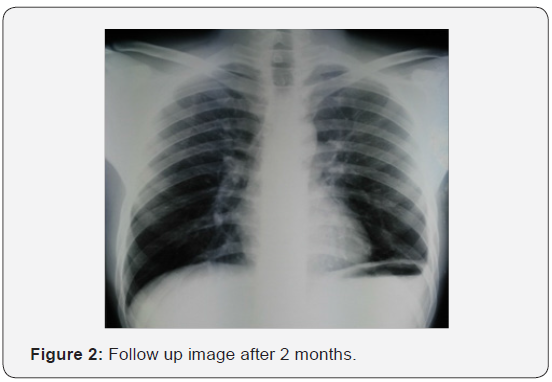Pulmonary Gunshot Wound Revealing Pulmonary Tuberculosis-Juniper publishers
JUNIPER PUBLISHERS-OPEN
ACCESS INTERNATIONAL JOURNAL OF PULMONARY & RESPIRATORY SCIENCES
Abstract
Pulmonary tuberculosis is a major flail of
mankind, 1/3 of the world population is infected. In Morocco, the
incidence is estimated by the Word Health Organization to 89 cases per
100 000 inhabitants. However, gunshot assaults are rare. Many
circumstances of discovery of tuberculosis were described. We present
the case of an incidental finding of pulmonary tuberculosis in a young
patient victim of a gun attack.
Abbreviations: WHO: Word Health Organization; TB: Tuberculosis; ARDS: Acute Respiratory Distress Syndrome
Pulmonary tuberculosis is a major health problem,
infecting 1/3 of the world population [1]. In Morocco, the incidence is
estimated by WHO to 89 cases per 100 000 inhabitants [2].
However, gunshot assaults are rare. Penetrating
traumas are dominated by knives attack. It is following this
epidemiological paradox that we present a case of pulmonary tuberculosis
revealed by a pulmonary wound after a gunshot attack.

Case Presentation
A young man of 23 years old without any past medical
history, from a modest socioeconomic family was admitted to the
emergency for left axillary gunshot wound that occurred 5 days
before. On admission he had stable hemodynamic parameters.
He presented severe dyspnea and left thoracic pain. Physical
exam revealed an axillary wound inlet of 0.5 cm, sub-cutaneous
emphysema and air pleural effusion. There was no outlet. The left
radial pulse was present and symmetric to the right. Chest X-ray
showed a left abundant hemopneumothorax with the gunshot
near aorta. An axillary chest tube was performed and 300 ml of
blood was evacuated. Chest CT angiography (Figure 1A & 1B)
showed linear parenchymal condensation of the upper and lower
left lobes representing the gunshot trajectory. This gunshot
was separated from the aorta by a tiny part of lung. Neither
hemomediastinum nor vascular injury was found. Surgery was
retained for gunshot extraction. A conservative posterolateral
thoracotomy showed blood clots and pachypleuritis. Also,
the gunshot crossed the upper left lobe from top to bottom,
penetrated the fissure on the side of lower lobe and fitted in the
posterior part of the Fowler segment. Removal of the gunshot
was performed after resecting a small collar of the lung. Other
findings showed nodules on the basal part of left lower lobe
which were biopsied. The postoperative course was uneventful.
Histology of nodules showed caseo-follicular pulmonary
tuberculosis. An antibacillary treatment was prescribed and the
patient showed good clinical and radiological evolution (Figure
2).

Discussion
Our observation is particular by the revealing mode of
pulmonary tuberculosis. Indeed, it was discovered after a lung
biopsy following incidental intra-operative suspicious lung
nodules during gunshot extraction. To our knowledge this
revealing mode has never been reported in literature. In France
during 2008, 76% of tuberculosis patient were diagnosed
following clinical signs, 3.9% following screening, 6.5% in the course of case investigation and 13.6% discovered incidentally
after other investigations [3]. These findings are almost similar
from ours in the Maghreb. Indeed, Ben Amar J et al showed
in a Tunisian study that 73.8% of cases were diagnosed in
community health care centers while 21% were discovered
during screening [4]. We estimate that only 10% of persons
who had contact with Koch bacilli will express the illness at one
time of their life [1]. Therefore, asymptomatic forms are those
usually discovered incidentally. In Maghreb and as in many other
endemic countries, TB affects active young population causing
significant socioeconomic impact. When it is asymptomatic,
radiological signs may be absent or discrete especially in
another clinical context such as hemothorax caused by gunshot
pulmonary wound. Indeed, the limited criterion on chest
radiography in the diagnosis of pulmonary tuberculosis has been
showed in many studies as it can remain normal in over 15%
of cases [5]. The CT scan which has better sensitivity remains
so limited in paucibacillary tuberculosis. The combination
of quantiferon dosage and CT scan would be an effective
alternative with positive predictive value of 96% and negative
predictive value of 92% [6]. Nevertheless, attention must be
drawn to the importance of Mycobacterium tuberculosis culture
and histological exam which remain the only way to confirm
the diagnosis and to begin an antibacillary therapy [6]. In fact,
the major risk is a reactivation of TB which will lead to active
tuberculosis in case of immunodeficiency [7]. However, reduced
immunity has been demonstrated in animals after pulmonary
contusion, hemorrhagic shock and in cases of severe trauma
[8]. This would imply an increased risk of TB reactivation in
the pulmonary contusion by gunshot. Furthermore, as the
major complications of pulmonary contusion is ARDS following
superinfection [9], then one wonders if tuberculous pneumonia
increases the risk of non-specific germs superinfection and
therefore of ARDS. Hence the importance of lung biopsy called
“de passage” that will confirm the diagnosis in this context of
asymptomatic tuberculosis.
Pulmonary gunshot wound may be a circumstance of
discovery of pulmonary tuberculosis clinically and radiologically
asymptomatic. A lung biopsy called “de passage” should be
performed for all suspicious lesions especially during a stressful
surgery where the surgeon will tend to neglect this type of
injury. Indeed histological confirmation of the asymptomatic
forms is primordial to begin antibacillary treatment which is the
only guarantee of a good prognosis in the context of tuberculous
pneumonia and pulmonary contusion.
To know more about Open Access International
Journal of Pulmonary & Respiratory Sciences please click on: https://juniperpublishers.com/ijoprs/index.php
Comments
Post a Comment